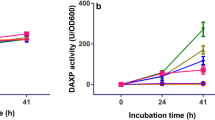Abstract
Capsular development and detailed morphology of exostructures of cowpeaRhizobium sp. JLn(c) were examined by transmission electron microscopy. The capsule development began at one pole in the form of polar fibrils in the early-exponential phase and extended further to cover the cell completely at the mid-exponential phase. Exostructures excreted by cowpeaRhizobium sp. JLn(c) have been found to be attached to cells or free in the culture medium; they consisted of mixtures of complex acidic exopolysaccharides (Type I) and neutral glucans (Type II). These polymers were separated by gel filtration and high-pressure liquid chromatography. The acidic microfibrils from JLn(c) were isolated and identified as cellulose by infrared spectral analysis. This acidic polymer was chemically characterized and was found to contain mainly glucose, galactose, glucuronic acid, mannose, fucose, pyruvate, acetate, and uronates.
Similar content being viewed by others
Literature Cited
Apte R, Modi VV (1983) A receptor protein from a host plant,Trigonella foenum-graecum, which binds toRhizobium meliloti strains. Experientia 39:509–510
Ashwell G (1966) Complex carbohydrates. Methods Enzymol 8:85–95
Bohlool BB, Schmidt EL (1974) Lectins: a possible basis for specificity in theRhizobium-legume root nodule symbiosis. Science 185:269–271
Carlson RW (1982) Surface chemistry. In: Broughton WJ (ed) Nitrogen fixation, Vol. 2,Rhizobium. Oxford: Clarendon Press, pp 199–234
Dandekar AM, Modi VV (1978) Interaction betweenRhizobium japonicum phage M-1 and its receptor. Can J Microbiol 24:685–688
Dazzo FB, Hubbell DH (1975) Cross-reactive antigens and lectin as determinants of symbiotic specificity in theRhizobium clover association. Appl Microbiol 30:1017–1033
Dazzo FB, Urbano MR, Brill WJ (1979) Transient appearance of lectin receptors onRhizobium trifolii. Curr Microbiol 2:15–20
Dische Z (1947) A new specific color reaction of hexuronic acids. J. Biol Chem 167:189–198
Dudman WF (1968) Capsulation ofRhizobium species. J Bacteriol 95:1200–1201
Dudman WF (1977) The role of surface polysaccharides in natural environments. In: Sutherland I (ed). Surface carbohydrates of the prokaryotic cell. London: Academic Press, pp 357–414
Dudman WF (1978) Structural studies of the extracellular polysaccharides ofRhizobium japonicum strains 71A, CC708 and CB1798. Carbohydr Res 66:9–23
Dudman WF, Heidelberger WF (1969) Immunochemistry of newly found substituents of polysaccharides ofRhizobium species. Science 164:954–955
Hestrin S (1949) The reaction of acetylcholine and other carboxylic acid derivatives with hydroxylamine and its analytical application. J Biol Chem 180:249–261
Hollingsworth R, Smith E, Ahmad MH (1985) Chemical composition of extracellular polysaccharides of cowpea rhizobia. Arch Microbiol 142:18–20
Kato G, Maruyama Y, Nakamura N (1981) Involvement of lectins inRhizobium-pea recognition. Plant Cell Physiol 66:609–614
Kijne JW, Smit G, Diaz CL, Lugtenberg JJ (1988) Lectinenhanced accumulation of manganese-limitedRhizobium leguminosarum cells on pea root hair tips. J Bacteriol 170:2994–3000
Luft JH (1964) Electron microscopy of cell extraneous coats as revealed by ruthenium red staining. J Cell Biol 23:54a
Luft JH (1971) Ruthenium red and ruthenium violet. I. Chemistry purification, methods of use for electron microscopy and mechanism of action. Anal Rec 171:347–368
Miller GL (1959) Use of dinitrosalicylic acid reagent for determination of reducing sugar. Anal Chem 31:426–428
Mody BR, Modi VV (1987) Peanut agglutinin induced alterations in capsular and extracellular polysaccharide synthesis and ex-planta nitrogenase activity of cowpea rhizobia. J Biosci 12:289–296
Mody BR, Modi VV (1989) Characterization of peanut agglutinin from tissues ofArachis hypogae and determination of a novel biological function of purified seed lectin in legume-Rhizobium interaction. Ind J Exp Biol 27:519–524
Mort AJ, Bauer WD (1980) Composition of the capsular and extracellular polysaccharides ofRhizobium japonicum. Plant Physiol 66:158–163
Mutaftschiev S, Vasse J, Truchet G (1982) Exostructures ofRhizobium meliloti. FEMS Microbiol Lett 13:171–175
Paau AS, Leps WT, Brill WJ (1981) Agglutinin from alfafa necessary for binding and nodulation byRhizobium meliloti. Science 213:1513–1515
Pate JL, Ordal EL (1967) The fine structures ofChondrococcus columnaris. J Cell Biol 35:37–51
Planke E, Kijne JW (1977) Binding of pea lectins to a glycan type polysaccharide in the cell walls ofRhizobium leguminosarum. FEBS Lett 73:64–66
Robertson BK, Aman P, Darvill AG, McNeil M, Albersheim P (1981) The structure of acidic extracellular polysaccharides secreted byRhizobium leguminosarum andRhizobium trifolii. Plant Physiol 67:389–400
Roth IL (1977) Physical structure of surface carbohydrates. In: Sutherland I (ed) Surface carbohydrates of the prokaryotic cell. London: Academic Press, pp 5–26
Sherwood JE, Vasse JM, Dazzo FB, Truchet GL (1984) Development and trifoliin A-binding ability of the capsule ofRhizobium trifolii. J Bacteriol 159:145–152
Sloenker JH, Orentas DG (1962) Pyruvic acid, a unique component of an exocellular bacterial polysaccharide. Nature (London) 194:478–479
Stacey G, Paau AS, Brill WJ (1980) Host recognition inRhizobium soyabean symbiosis. Plant Physiol 66:609–614
Sutherland IW (1977) Microbial exopolysaccharide synthesis. In: Sanford PA, Laskin A (eds) Extracellular microbial polysaccharides. Washington, DC: American Chemical Society, pp 40–57
Tsien HC, Schmidt EL (1977) Polarity in the exponential-phase ofRhizobium japonicum cells. Can J Microbiol 23:1274–1284
Vasse JM, Dazzo FB, Truchet GL (1984) Re-examination of capsule development and lectin-binding sites onRhizobium japonicum 311B110 by the glutaraldehyde/ruthenium red/uranyl acetate staining method. J Gen Microbiol 130:3037–3047
Vincent JM (1970) A manual for the practical study of the root nodule bacteria. IBP Hand book No. 15. Oxford: Blackwell Scientific Publications
Zevenhuizen LPTM (1981) Cellular glycogen,β-1,2-glucan, polyβ-hydroxybutyric acid and extracellular polysaccharides in fast growing species ofRhizobium. Antonie van Leeuwenhoek 47:481–497
Author information
Authors and Affiliations
Rights and permissions
About this article
Cite this article
Mody, B.R., Bindra, M.O. & Modi, V.V. Capsule development and structural characterization of acidic extracellular polysaccharides secreted by cowpea Rhizobia. Current Microbiology 20, 145–152 (1990). https://doi.org/10.1007/BF02091989
Issue Date:
DOI: https://doi.org/10.1007/BF02091989




